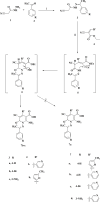Synthesis of heterocycle based carboxymethyl cellulose conjugates as novel anticancer agents targeting HCT116, MCF7, PC3 and A549 cells
- PMID: 40783442
- PMCID: PMC12335502
- DOI: 10.1038/s41598-025-14146-1
Synthesis of heterocycle based carboxymethyl cellulose conjugates as novel anticancer agents targeting HCT116, MCF7, PC3 and A549 cells
Abstract
Toward developing anticancer agents, heterocycle-based carboxymethyl cellulose conjugates have been synthesized. 2-Cyano-N'-(aryl/heteroarylethylidene)acetohydrazides and ethyl 2-cyano-3-(heteryl)acrylates were utilized as precursors for the synthesis of pyridine-based compounds. The chemical structures of the synthesized derivatives were characterized using various spectroscopic techniques, including 1H-, 13C-NMR, Fourier transform infrared spectroscopy (FTIR), as well as scanning electron microscopy (SEM).The anticancer effects of compounds on HCT-116, MCF-7, PC3 and A549 cancer cell lines were investigated and their cytotoxicity against RPE-1 normal cells was estimated to determine their safety. Compounds 4b and 7c exhibit high selectivity toward cancer cells while maintaining a strong safety margin for normal cells. The results demonstrated that the novel heterocycle-based carboxymethyl cellulose conjugates are promising and can be further evaluated as a potential therapeutic agent.
Keywords: Anticancer; Carboxymethyl cellulose; Pyridine; Synthesis.
© 2025. The Author(s).
Conflict of interest statement
Declarations. Competing interests: The authors declare no competing interests. Ethics approval: The study was approved by the Medical Research Ethics Committee (MERC) fedral (accurance no. : FWA 00014747).
Figures











Similar articles
-
Novel purine-linked 1,2,3-triazole derivatives as effective anticancer agents: design, synthesis, docking, DFT, and ADME-T investigations.Sci Rep. 2025 Jul 23;15(1):26853. doi: 10.1038/s41598-025-95669-5. Sci Rep. 2025. PMID: 40702234 Free PMC article.
-
Phyto-Fabrication Tribulus terrestris Mediated Iron Oxide Nanoparticles: A Promising Approach of Antioxidant and Anticancer Activities via in vitro and in silico Studies.Front Biosci (Landmark Ed). 2025 May 30;30(6):25164. doi: 10.31083/FBL25164. Front Biosci (Landmark Ed). 2025. PMID: 40613274
-
Heterocyclic androstane derivatives targeting hormone-related cancers: Synthesis, bioactivity and docking studies.Eur J Med Chem. 2025 Oct 15;296:117850. doi: 10.1016/j.ejmech.2025.117850. Epub 2025 Jun 6. Eur J Med Chem. 2025. PMID: 40505260
-
Management of urinary stones by experts in stone disease (ESD 2025).Arch Ital Urol Androl. 2025 Jun 30;97(2):14085. doi: 10.4081/aiua.2025.14085. Epub 2025 Jun 30. Arch Ital Urol Androl. 2025. PMID: 40583613 Review.
-
Exploring the Structure-Activity Relationship of COX Inhibitors with Anticancer Effects: A Comprehensive Review.Curr Top Med Chem. 2025;25(9):1069-1104. doi: 10.2174/0115680266333495241011063253. Curr Top Med Chem. 2025. PMID: 39440774 Review.
References
-
- Manaithiya, A. et al. Current status of novel pyridine fused derivatives as anticancer agents: An insight into future perspectives and structure activity relationship (SAR). Curr. Top. Med. Chem.21 (25), 2292–2349 (2021). - PubMed
-
- Prachayasittikul, S. et al. Roles of pyridine and pyrimidine derivatives as privileged scaffolds in anticancer agents. Mini Rev. Med. Chem.17 (10), 869–901 (2017). - PubMed
-
- Henry, G. D. De Novo synthesis of substituted pyridines. Tetrahedron29 (60), 6043–6061 (2004).
MeSH terms
Substances
LinkOut - more resources
Full Text Sources

